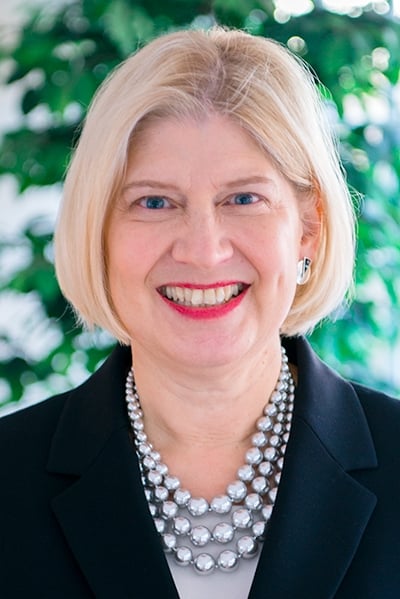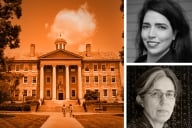You have /5 articles left.
Sign up for a free account or log in.

Lee Zak, incoming president of Agnes Scott College
Agnes Scott College
When Agnes Scott College announced last week that Leocadia I. Zak would become its next president, the women’s college in Georgia did not insistently trumpet her experience with the federal government.
The college’s announcement first noted Zak’s roots as a graduate of Mount Holyoke College and her law degree from Northeastern University. It also described her as someone with an “extensive background in international economic development and international project finance.”
Only after those descriptions did the announcement detail the seven years Zak spent as director of the U.S. Trade and Development Agency during President Obama’s years in office.
Nonetheless, Zak’s background in government means she stands at the convergence of several trends affecting who becomes a college president. The pathways to the presidency are remarkably unsettled right now, with the traditional talent pipeline of tenured faculty members who have risen through the administrative ranks narrowing, a large number of longtime presidents expected to retire and boards of trustees increasingly searching for so-called nontraditional presidential candidates from outside academe. At the same time, faculty members and search committees still value familiarity with the complex and often slow-moving world of higher education.
Obama-era officials have done fairly well in the midst of those trends. In addition to Zak, several others have become college presidents or chancellors. Sylvia Mathews Burwell, the former health and human services secretary and Office of Management and Budget director, became president of American University last year. Rebecca Blank, acting secretary of the U.S. Department of Commerce from 2012 to 2013, became chancellor of the University of Wisconsin at Madison in July 2013. That same year, the University of California system presidency was awarded to Janet Napolitano, a former Arizona governor who at the time was secretary of homeland security.
That’s not to count some other lower-ranking Obama administration officials who became college presidents. Karol Mason, a former assistant attorney general, became president of the John Jay College of Criminal Justice at the City University of New York in 2017, and Mark Mitsui, a deputy assistant secretary within the Department of Education, became president of Portland Community College in 2016.
No one can say for sure whether the Obama regime will finish with a better track record of producing college presidents than past administrations -- or even how such a track record should be measured. Those who served under Obama and other past U.S. presidents have faced some high-profile challenges when leading higher education institutions, so measuring numbers without quality would be folly. What can be said is that as colleges and universities seek new sources of presidential talent today, they’re finding appealing qualities in those who have experience leading federal agencies.
“Boards are willing to look broadly at people who demonstrate leadership skills,” said Jan Greenwood, an executive search consultant who is co-owner and partner at Greenwood/Asher & Associates in Miramar Beach, Fla. (Greenwood did not work on any of the searches referenced in this article.) “Are you looking for a president or chancellor who has held the title of president, or are you more open to people who have demonstrated the skill set needed for the leadership position?”
Looking for certain skill sets tends to broaden the candidate pool to include those who have held positions in the federal government, state government and business, Greenwood said. Such candidates have demonstrated skills in a vastly different setting from higher ed, however, so cultural fit is a key consideration.
Prospective candidates from outside higher ed often say the decision-making process at colleges and universities is too slow, Greenwood said. So an ideal candidate has a proven track record in a higher ed setting, even if he or she isn’t working at a college or university at the moment of a presidential search.
It’s easy to see how a federal administrator might be a fit. They are used to interacting with different constituencies and dealing with the often-grinding pace of change in the government.
Yet search committees can be wary of candidates from the federal government, state governments and even the military, Greenwood said. Committee members worry such candidates will be overly bureaucratic or autocratic.
“Candidates have to be in apposition to convince search committees and boards that they’re not bureaucratic or autocratic, that they do understand the culture and respect the culture,” Greenwood said.
Blank’s hiring as UW Madison chancellor provides an example of how that process plays out. The search committee looked at her candidacy from two angles: her professional qualifications and her academic credentials.
On the professional side, the fact that she did government work was not as important as the type of work she was doing, said David McDonald, a history professor at UW Madison who chaired the search committee in Blank’s hiring. Blank was given a complex portfolio during her time at the Department of Commerce, which includes branches dealing with both trade and scientific matters. The National Oceanic and Atmospheric Administration falls under the Department of Commerce, McDonald noted.
“It was a directorship of a very large and complex organization, which is what any modern research university is,” McDonald said.
At the same time, Blank’s academic chops were well recognized. Her background includes serving on the faculties at Northwestern and Princeton Universities. She was a dean and professor of public policy and economics at the University of Michigan, where she built several programs.
“It had to be somebody who could earn tenure in one of our tenure-granting departments,” McDonald said. “For us it was key, that tenure ability, because it showed professional commitment to our endeavor and showed that the person takes it seriously.”
The search leading to Napolitano becoming UC system president hit on some of the same themes. Napolitano’s success was less about her being a cabinet member in the Obama administration than it was about her experience running a large, complex public enterprise with a diverse staff and many different constituencies, according to a UC spokeswoman. Her background at the Department of Homeland Security played a part, but Napolitano’s time as the governor of Arizona was perhaps more important, because she was well regarded for her work with education.
Of course, both Blank and Napolitano have had to deal with controversies during their tenures at their respective institutions. UW Madison’s business school dean in December announced her resignation after just one semester, because her vision for the school was not aligned with Blank’s. Blank has also had to navigate struggles over budgets and tenure in Wisconsin. In California, Napolitano ran into a rocky time of late, taking flak from regents in November following accusations her office sought to tamper with a state audit in an incident that led to the resignation of two of her top aides.
Still, Blank and Napolitano’s challenges pale in comparison to those that ultimately consumed another former president’s high-level appointee who went on to become a university president. Kenneth Starr was solicitor general under President George H. W. Bush (and, as independent counsel, famously investigated President Clinton). He went on to become the president of Baylor University for six years before resigning in 2016 amid uproar over the way the university handled sexual assaults.
Clearly, former federal officials are not guaranteed success in their college or university presidencies.
But the latest to try, Zak at Agnes Scott, thinks the pathway from U.S. presidential administration to college president can work in cases where the fit is right. Agnes Scott has become known for its signature SUMMIT program, which attempts to blend the liberal arts with leadership development and a global emphasis. Zak points out she focused on global economic development as U.S. Trade and Development Agency director. Her degree from Mount Holyoke, a women’s college, is also important.
“It allows me, from the beginning, to have an understanding of the environment,” she said. “Of course, every college is different, but it really allows me to have a view toward the culture, a view toward some goals and aspirations.”
SUMMIT has been successful at Agnes Scott, helping it draw some of the largest first-year classes in its history. But Zak will have to deal with challenges. Women’s colleges face an uphill climb as they attempt to attract students at a time when single-sex education has dwindled in popularity. Many small liberal arts colleges are struggling with enrollment and finances. Agnes Scott’s financial situation has improved of late, but it has yet to completely close budget deficits or reach long-term enrollment goals.
Zak believes her history prepares her to face the challenges.
“What I came from as a background is very much an environment where, not only did I have to lead an organization and be the thought leader, but also be the businessperson who had to ensure we came in on time and on budget, and with excellence,” she said.
Zak also shared her thoughts on why former Obama officials are taking the helm of colleges.
“I do think it is a matter of culture and values,” she said. “Individuals that were attracted to the administration have those views and values, and as a result have been attracted to education.”
Collectively, Zak, Burwell, Blank and Napolitano’s holding higher ed positions stands out because they are all women. Mason’s leadership of John Jay stands out because she is an African-American woman, and Mitsui, at Portland Community College, is one of a small percentage of Asian and Asian-American college presidents.
Nontraditional presidents are less likely to be women than men, research from the dean of the University of Virginia’s Darden School of Business has found -- raising questions about whether boards of trustees stick to a dated image of the white male college president when they consider hires from unorthodox backgrounds. Less than a third of all college presidents were women in 2016, according to the latest version of the American College President Study from the American Council on Education. About 8 percent of presidents were African-American, but only a third of African-American presidents were women, and about 2 percent were Asian or Asian-American.








